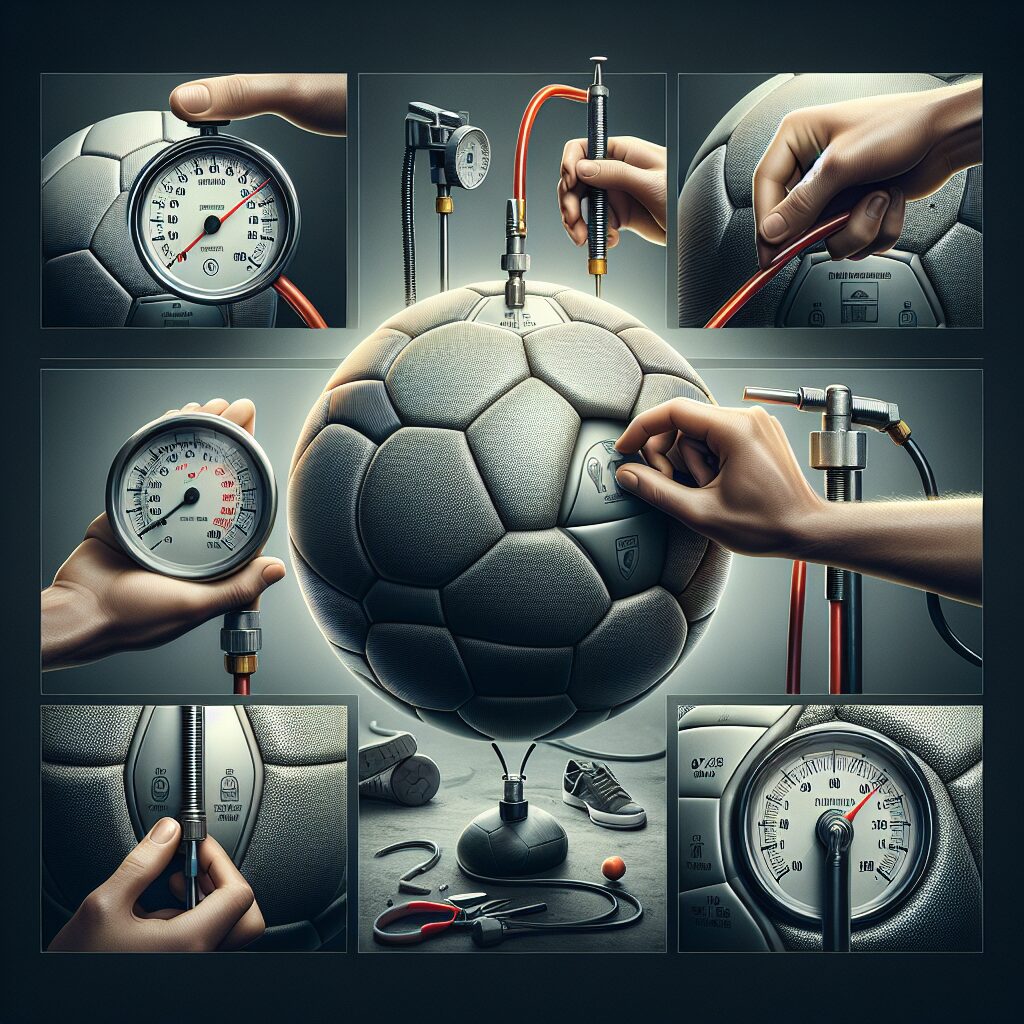Ball Inflation Techniques: Achieving Optimal Pressure
In the world of sports, the pressure inside a ball can make all the difference in performance. Whether it’s a soccer ball, basketball, or even a tennis ball, achieving optimal pressure is essential for players to showcase their skills to the fullest. The term “ball inflation techniques” refers to the methods and strategies used to ensure that a ball is filled with the right amount of air to meet the specific requirements of each sport.
Proper ball inflation techniques have a significant impact on the overall playability of the ball. For instance, an underinflated soccer ball may not bounce as expected, leading to unpredictable movements and difficulties in controlling the ball during a match. On the other hand, an overinflated basketball may become overly rigid, affecting shooting accuracy and the overall feel of the game. Moreover, the weight and circumference of a ball can also be affected by proper inflation techniques, directly influencing players’ performance in terms of speed, distance, and accuracy of their shots.
Moving forward, let’s explore some key takeaways regarding ball inflation techniques. First, we will delve into the importance of understanding the specific pressure requirements for different sports. Then, we will discuss the various methods and tools available for measuring and adjusting ball pressure. Lastly, we will explore the impact of optimal inflation techniques on player performance and the overall game experience. By the end of this article, you will have a comprehensive understanding of how to achieve optimal ball pressure and elevate your game to new heights.
Key Takeaways
1. Optimal ball inflation pressure varies for different sports and playing conditions, but it is essential to achieve the right pressure to maximize performance and safety.
2. Under-inflated balls can lead to reduced control, accuracy, and distance in various sports, affecting overall gameplay and potentially causing injuries.
3. Over-inflated balls can be harder and less comfortable to play with, affecting players’ ability to grip, kick, or handle the ball properly.
4. Proper ball inflation techniques include using an accurate pressure gauge, considering the manufacturer’s recommendations, and adjusting the pressure based on personal preferences within the recommended range.
5. Regularly monitoring and maintaining the ball’s pressure can help optimize performance, prolong the ball’s lifespan, and minimize the risk of injuries during sports activities.
What are the Best Ball Inflation Techniques for Achieving Optimal Pressure?
Importance of Proper Ball Inflation
Ball inflation is a crucial aspect when it comes to various sports like basketball, soccer, volleyball, and many others. Optimal pressure ensures optimal performance and enhances the player’s experience. Whether you are a professional athlete or a recreational player, understanding the ball inflation techniques is essential for maintaining consistency and accuracy in your game.
Choosing the Right Ball Pressure
Determining the proper inflation pressure for a ball depends on its specific sport and its intended use. The recommended pressure is usually indicated on the ball or provided by the manufacturer. It’s vital to follow these guidelines to achieve the desired performance on the playing field.
Using a Pressure Gauge
One of the most accurate ways to measure ball pressure is by using a pressure gauge. These handy tools ensure precise inflation by providing numerical readings. The pressure gauge eliminates guesswork and allows you to inflate the ball to the recommended pressure without any ambiguity.
Pumping the Ball
Pumping a ball requires careful attention to detail to achieve optimal pressure. Here are some tips to consider:
- Start by wetting the needle with a small amount of water or lubricant to ensure smooth insertion into the ball’s valve.
- Insert the needle into the valve slowly, making sure it goes straight in without any forceful bending.
- Pump the ball in short, controlled bursts to prevent overinflation or sudden pressure changes.
- Regularly check the pressure using a gauge during pumping to ensure you reach the desired pressure level.
- Once the ball reaches the recommended pressure, carefully remove the needle from the valve without losing air.
Checking Ball Pressure
After inflating the ball, it’s crucial to check if it has reached the optimal pressure. To do so:
- Place the ball on a flat surface and press it down with your palm or fingers.
- A ball inflated correctly should feel firm but not too hard. It should provide a slight give when pressed and quickly return to its original shape.
- If the ball feels excessively hard or soft, use a pressure gauge to confirm the pressure and adjust accordingly.
Maintaining Ball Pressure
Once you have achieved optimal pressure, it’s important to maintain it to ensure consistent performance. Here are some tips to keep in mind:
- Regularly check the ball pressure before each game or practice session to ensure it hasn’t decreased.
- Store the ball in an appropriate environment, as extreme heat or cold can affect the pressure.
- Avoid overinflating the ball as it can lead to reduced grip, bounce, and even damage.
- Regularly clean the ball and inspect for any leaks or damage that may affect the pressure.
What are some common problems related to ball inflation and how to fix them?
1. Ball Losing Pressure Quickly
If you notice your ball is losing pressure rapidly after inflation, there might be a leak. To fix this issue:
- Submerge the ball in water and look for air bubbles escaping. Once you find the area, mark it with a pen or tape for repair.
- Using a ball patch kit, apply adhesive and patch over the marked area. Ensure a secure seal and let it dry completely before reinflation.
2. Difficulty Inserting Needle into the Valve
If you find it challenging to insert the needle into the ball’s valve, try the following:
- Apply a small amount of lubricant or saliva on the needle for easier insertion.
- Make sure the needle is aligned correctly with the valve and insert it slowly with a gentle twisting motion.
3. Overinflated Ball
If you accidentally overinflate the ball, you can release some air using these steps:
- Place the pump’s needle partially into the valve to release a small amount of air.
- Repeat the process gradually until you reach the desired pressure.
4. Ball Feels Too Soft
In case the ball feels too soft even after inflation, try the following:
- Recheck the pressure using a pressure gauge to ensure it meets the recommended level.
- If necessary, carefully pump more air into the ball using short bursts to avoid overinflation.
Frequently Asked Questions
1. Why is ball inflation important for achieving optimal pressure?
Proper ball inflation is crucial for achieving optimal pressure because it directly affects the performance and playability of the ball. Over-inflated or under-inflated balls can affect the bounce, control, and accuracy of the game, ultimately impacting the overall experience for players.
2. How do I determine the optimal pressure for my ball?
The optimal pressure for a ball depends on various factors such as the type of sport, playing surface, and personal preference. It is recommended to consult the manufacturer’s guidelines or the sport’s governing body for specific inflation recommendations. Additionally, using a pressure gauge is a reliable way to measure and adjust the pressure to the desired level.
3. What happens if a ball is over-inflated?
When a ball is over-inflated, it becomes too hard and can lead to excessive bouncing, reduced grip, and increased risk of injury. The ball may also lose its shape and become more challenging to control, affecting gameplay negatively.
4. What problems can occur if a ball is under-inflated?
If a ball is under-inflated, it tends to become softer and loses its responsiveness and stability. This can result in reduced accuracy, unpredictable bounces, and less control during gameplay. Under-inflated balls also tend to absorb more impact, potentially causing discomfort or injury for players.
5. Can I use an ordinary pump to inflate my sports balls?
Yes, an ordinary pump can be used to inflate sports balls. However, it is essential to ensure that the pump has the correct needle attachment compatible with the ball valve. Additionally, using a pressure gauge and following the inflation guidelines will help maintain optimal pressure.
6. How often should I check and adjust the inflation of my ball?
The frequency of checking and adjusting the inflation of your ball depends on several factors, including regular usage, environmental conditions, and the specific sport. As a general guideline, it is recommended to check the ball’s pressure before each use and make necessary adjustments to maintain optimal inflation.
7. Can I use my mouth to inflate a ball?
While it is possible to inflate a ball using your mouth, it is not recommended. Using your mouth can introduce moisture and bacteria into the ball, which may affect its lifespan and performance. It is best to use an appropriate pump to inflate the ball to ensure proper hygiene and avoid potential damage.
8. Are there any specific techniques for inflating different types of balls?
Yes, different types of balls may require specific techniques for optimal inflation. For example, some balls may need to be partially inflated before inserting the needle, while others may require different valve attachments. It is advisable to refer to the manufacturer’s instructions or seek guidance from experienced players or coaches for the best techniques.
9. Can over-inflating or under-inflating a ball cause it to burst?
Both over-inflating and under-inflating a ball can increase the risk of it bursting. Over-inflating puts excessive pressure on the ball’s surface, making it more susceptible to punctures or tears. On the other hand, under-inflating can cause the ball to be more vulnerable to impact, potentially leading to bursting if subjected to excessive force. It is crucial to maintain optimal pressure to minimize this risk.
10. How can I prolong the lifespan of my inflated ball?
To extend the lifespan of your inflated ball, it is essential to store it properly when not in use. Avoid exposing the ball to extreme temperatures or direct sunlight, as this can cause damage and affect the pressure. Furthermore, regularly inspecting and maintaining the ball’s inflation, cleaning it as per the manufacturer’s instructions, and avoiding rough surfaces during gameplay can help prolong its lifespan.
Final Thoughts
Ball inflation techniques are crucial for achieving optimal pressure and ensuring an enjoyable sports experience. By understanding the importance of proper inflation, consulting guidelines, and using the right tools, players can enhance their gameplay, control, and accuracy. Regularly checking and adjusting the pressure, as well as adopting proper storage and maintenance practices, will not only prolong the lifespan of the ball but also contribute to a safer and more satisfying sporting experience for everyone involved.
Remember, a well-inflated ball is the foundation for a thrilling game, providing the right balance of bounce, grip, and responsiveness. So, take the time to familiarize yourself with the recommended pressure for your specific sport and invest in a quality pressure gauge and pump. By following these practices, you can optimize your ball inflation techniques and elevate your performance on the field or court.




